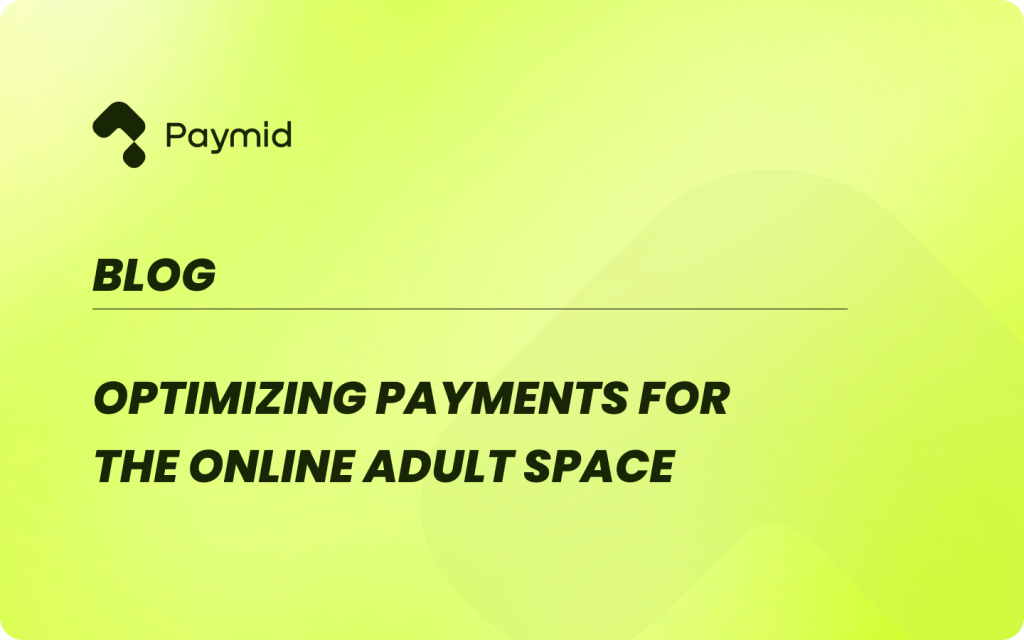Optimizing Online Payments for the Adult Industry

The adult industry faces unique challenges when processing online payments. High-risk classification, regulatory scrutiny, and consumer privacy concerns demand tailored strategies to ensure seamless, secure, and cost-effective transactions. This blog post explores key approaches to optimizing payment systems for adult businesses, balancing compliance, user experience, and profitability.
Understanding the High-Risk Landscape
The adult industry is often labeled “high-risk” by payment processors due to elevated chargeback rates, legal complexities, and reputational concerns. This classification can lead to higher processing fees, stricter compliance requirements, and limited access to mainstream payment platforms. To navigate this:
-
Partner with Specialized Payment Processors: Choose processors experienced in high-risk industries, such as CCBill, Epoch, or Verotel, all which are connected through Paymid Connections. These providers understand the adult sector’s nuances and offer tailored solutions, including robust fraud detection and chargeback management.
-
Diversify Payment Gateways: Relying on a single gateway increases risk if the provider terminates service. Integrate multiple gateways to ensure redundancy and maintain uptime during disruptions.
Prioritizing Security and Compliance
Security is non-negotiable in the adult industry, where data breaches can erode trust and lead to legal repercussions. Compliance with regulations like PCI DSS and regional laws (e.g., GDPR for EU customers) is equally critical.
-
Implement PCI DSS Compliance: Ensure your payment system adheres to Payment Card Industry Data Security Standards. Use tokenization to encrypt sensitive card data, reducing the risk of breaches.
-
Leverage 3D Secure Authentication: Tools like Verified by Visa or Mastercard SecureCode add an extra layer of fraud prevention by requiring customer authentication during transactions.
-
Stay Regionally Compliant: Understand local regulations, such as age verification mandates or content restrictions, to avoid penalties. For example, the EU’s PSD2 requires Strong Customer Authentication (SCA) for online payments.
Enhancing User Experience
A frictionless checkout process boosts conversions, especially in the adult industry, where discretion and speed are paramount.
-
Offer Diverse Payment Methods: Beyond credit cards, support digital wallets (e.g., PayPal, Apple Pay), cryptocurrencies, and regional payment options like SEPA for Europe. Crypto payments, in particular, appeal to privacy-conscious users and reduce chargeback risks.
-
Optimize for Mobile: With mobile traffic dominating adult sites, ensure your payment flow is responsive and intuitive on smartphones. Simplify forms and minimize clicks to reduce cart abandonment.
-
Enable One-Click Payments: For subscription-based models, store payment details securely (with user consent) to enable quick repeat purchases, mimicking the convenience of mainstream platforms like Amazon.
Managing Chargebacks Effectively
Chargebacks are a significant challenge in the adult industry, often driven by buyer’s remorse or unauthorized transactions. High chargeback ratios can lead to penalties or account termination.
-
Use Clear Billing Descriptors: Ensure your business name or a neutral descriptor appears on customer statements to avoid confusion and disputes. Avoid vague or misleading names that trigger chargebacks.
-
Implement Proactive Fraud Detection: Use AI-driven tools to flag suspicious transactions based on IP geolocation, device fingerprinting, or unusual purchase patterns.
-
Offer Robust Customer Support: Provide 24/7 support via chat, email, or phone to resolve issues before they escalate to chargebacks. Clear refund policies can also deter disputes.
Leveraging Cryptocurrency for Privacy and Savings
Cryptocurrencies like Bitcoin, Ethereum, or stablecoins are gaining traction in the adult industry due to their anonymity and lower transaction fees.
-
Integrate Crypto Payment Gateways: Platforms like CoinPayments or BitPay simplify crypto integration, converting payments to fiat if needed.
-
Educate Users: Many customers are unfamiliar with crypto. Provide clear instructions or tutorials to encourage adoption, emphasizing privacy and security benefits.
-
Monitor Volatility: If holding crypto, use hedging strategies or instant fiat conversion to mitigate price fluctuations.
Reducing Costs Without Sacrificing Quality
High-risk processing fees can erode margins, but cost-saving measures can help without compromising service.
-
Negotiate Fees: Established businesses with strong transaction histories can often secure lower rates from processors. Regularly review contracts to ensure competitive terms.
-
Analyze Transaction Data: Use analytics to identify high-cost payment methods or regions with frequent declines. Redirect traffic to more cost-effective options where possible.
-
Automate Reconciliation: Streamline accounting with tools that integrate payment data into your CRM or ERP, reducing manual errors and labor costs.
Building Trust Through Transparency
In an industry where stigma and skepticism persist, transparency fosters customer loyalty.
-
Display Security Badges: Showcasing PCI compliance, SSL certificates, or trusted processor logos reassures users during checkout.
-
Communicate Privacy Policies: Clearly explain how user data is handled, stored, and protected. Highlight anonymized payment options like crypto or prepaid cards.
-
Be Upfront About Costs: Avoid hidden fees or unclear subscription terms, which can lead to disputes and damage your reputation.
Conclusion
Optimizing online payments in the adult industry requires a strategic blend of security, user experience, and cost management. By partnering with specialized processors, embracing diverse payment methods, and prioritizing compliance, businesses can reduce risks and boost conversions. As consumer preferences evolve, staying agile—whether through crypto adoption or mobile optimization—will keep your payment system competitive and resilient.
For adult businesses looking to scale, investing in a robust, customer-centric payment infrastructure isn’t just a necessity—it’s a growth driver. Start by auditing your current setup, exploring high-risk-friendly processors, and testing new payment options to find the perfect balance for your audience.

